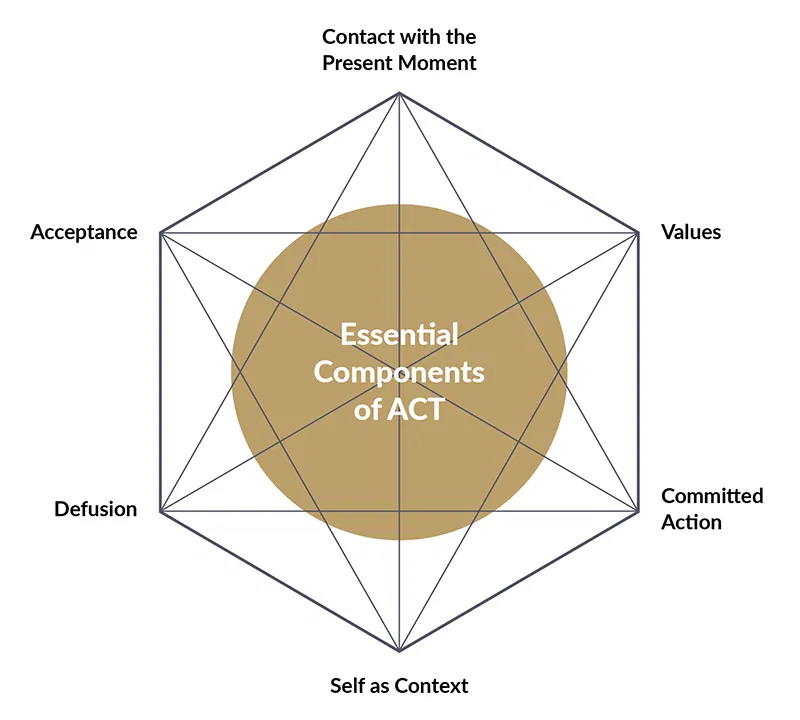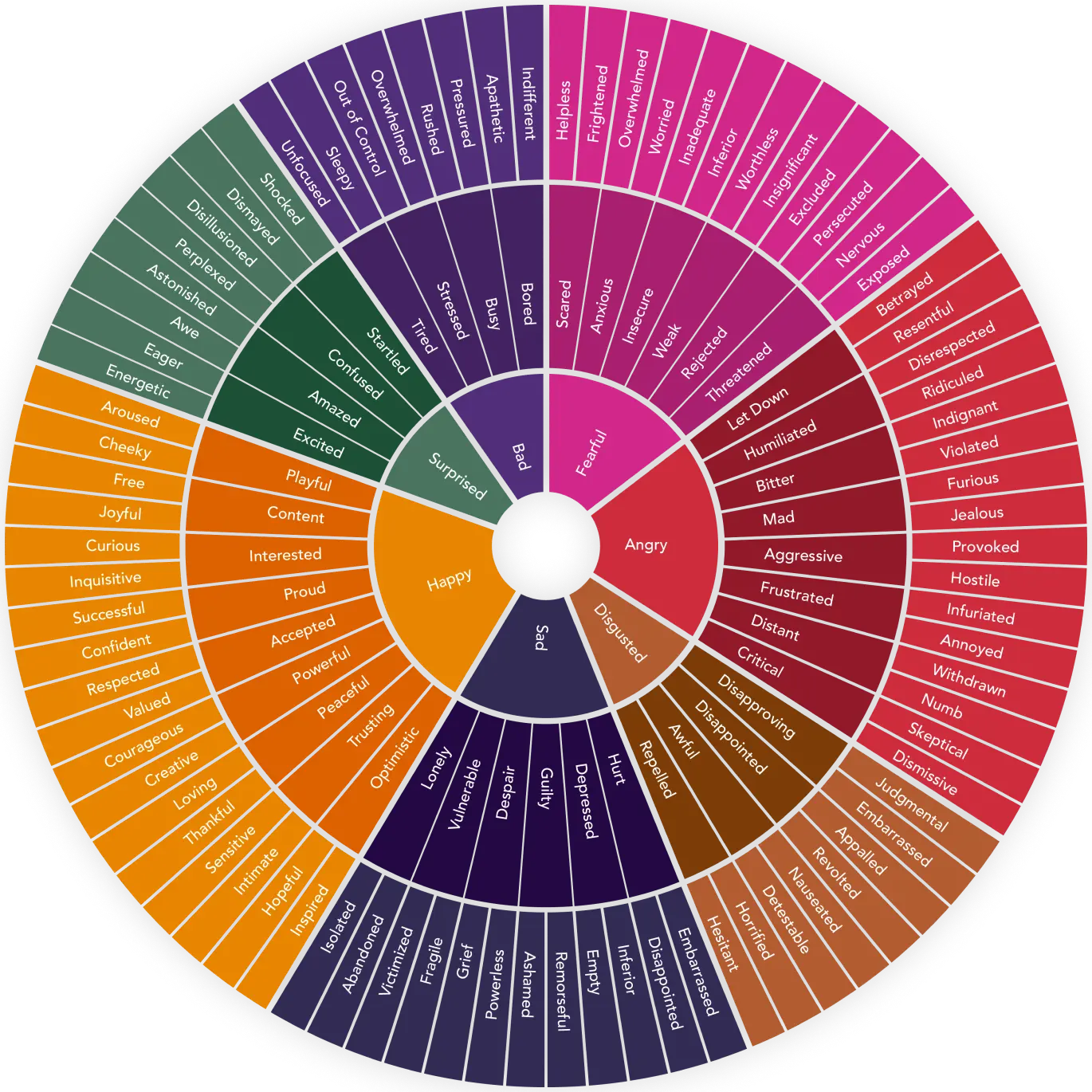
It’s a rainy day outside and I’m having a bad body day (what I call days that I’m hurting which could be from any number of things associated with my Ehlers-Danlos Syndrome). I love the rain (perfect for reading or writing!) and a painful day is not unusual. And yet, I just watched a TED talk that made me want to bawl my eyes out (which IS unusual).
Why am I so emotional at the moment? Honestly, I have no idea. But in the past I would have berated myself harshly, mentally blocked and locked away whatever thoughts/memories dredged up because of the emotion or preceding the emotion, and then patted myself on the back because look how I’m able to function so well?
But I don’t do this anymore.
My emotions and I have a different…relationship now, a different understanding. And this ties in perfectly with ACT’s component of Acceptance and the essential overarching theme of psychological flexibility (that’s a doozy of a phrase!).

REMIND ME AGAIN WHAT ACT IS?
ACT stands for Acceptance and Commitment Therapy, which Kendra Cherry, MSEd on verywellmind states is “a form of psychotherapy that helps people learn to adapt to changes in the world and in themselves while staying true to their personal values and goals.” It does this through contact with the present moment (mindfulness, which I posted about here), acceptance (which we’ll talk about today), [thought] defusion and self as context (which we’ll talk about later). ACT was introduced to me when I was in some heavy duty therapy, and it’s been super helpful for me. I’m hoping it will be for you as well.
SO, THEN WHAT IS PSYCHOLOGICAL FLEXIBILITY?
Psychological flexibility is the ability we have to accept the present moment and all the uncomfortable thoughts and feelings that may arise. I think of it like going to the gym. We know we need to increase our strength and flexibility (and hopefully shed pounds too). So, we exercise our muscles to gain said strength and flexibility (and hopefully lose that weight too).
We have to exercise in three ways to become psychologically flexible:
- Being present: This goes back to being mindful, being aware of what is going on inside and outside of us. Instead of excessively worrying about the future or ruminating about the past, we focus on being mindful of the present moment.
- Openness: This is us being mentally and emotionally open-minded to new experiences, different opinions, and challenging situations. We often get stuck in our own ruts of thinking and perceiving (cognitive distortions!) or at least I do! Openness is being open to new ways of doing things and getting help and asking my thoughts, “Are you being helpful right now?” If they aren’t, openness is replacing those thoughts with re-framed thoughts (e.g. I think I am a failure. Pause, catch the thought, and ask myself, Is this thought helpful to me? Reframe and replace the thought to something like, I feel like a failure but this is not true, evidenced by a,b,c).
- Acceptance: This is acknowledging, processing and accepting our thoughts and emotions – which is without doubt, the HARDEST EXERCISE for me to do, and yet, plausibly, the most important.
MY EXPERIENCE WITH EMOTIONS
I know not everyone grew up like this, but I’m betting a lot of you did. I grew up being taught, directly and indirectly, that emotions and emoting (or showing those emotions) was bad. Or at least the bad ones were negative and something we should avoid.
For starters, my dad was the one who taught me that crying was for sissies (a very common sentiment among males), and we were going to be stronger than that (ironically even though I was not male). I worshipped my dad, so it was my whole life’s mission to make him happy enough to want to stay at home (he deployed a lot with the army and then left us when I was 12 in large part because PTSD hijacked his mind). He taught this view on crying through the following scenarios:
- If I complained about something hurting, he’d laugh at me and tell me that if I really wanted something to hurt, I should get him an ax and he’d chop it off.
- If I legit injured myself, he never asked if I was ok.
- If I cried because I was sad or upset, he simply ignored me.
- If I cried because I didn’t want to do something, he’d shake his head in a very disappointed manner. If I added a little bit of back talk in there too, he’d whoop me with his hand, a belt, or a flyswat – whatever was nearby.
- When I had an accident and a permanent tooth went flying out of my mouth, root and all, Dad took me to the emergency dentist. The resident on duty had no idea what he was doing and literally just stuck the tooth back into the missing cavity without anesthesia or any numbing medicine. When I didn’t cry, Dad proudly patted my shoulder and said, “That’s my girl. Can you hear that grown ass man yelling in the next room? Yeah, you are stronger than that.”
I was 5, mind you.
Lessons learned from Dad: Crying never did a damn good thing for you. It’s useless and shameful, even if you have a legitimate reason to cry. Be stronger than your pain. If you can’t be, you’re an embarrassment.
But it wasn’t just my dad who shaped my worldview on emotions.
My church was a huge part of my life during my formative years and its lessons were a little bit more insidious:
- Anger was sinful. I mean, Jesus and God could be angry. They overturned temple money tables and smote entire cities off the face of the earth. But we as humans have no place to be angry. If we were angry that meant we were involved in sinful behavior, like being disrespectful, yelling, saying cruel things we couldn’t take back, being destructive, etc.
- Anger and forgiveness were not compatible with one another. If someone legitimately upset you or did something terrible to you, you had to forgive them. Just like Jesus, you had to forgive and forget. If Jesus forgave us, then we, by all means, must forgive one another. Anger proved we were harboring unforgiveness in our hearts, which at best meant that we would just be eaten up inside and at worst meant that God would not be pleased with you.
- Fear was proof that we weren’t trusting God. To be afraid meant we were like Jesus’ disciples in the sinking boat…we were weak, unbelieving followers. “Oh, ye of little faith” could be translated to “you of poor, weak, pitiful, faithless souls.” If I didn’t have enough faith, I thought that meant God would do his version of sighing in exasperation and wonder why again he had decided to save us? And then upon thinking about it further, he would be like, “Nope, I’m just not going to do it. Rachel is not worth saving.” That was my worst fear of all.
- Sadness showed that we were ungrateful. We must always be smiling and remembering all the good things God has done for us, even if something legitimately terrible happened to us.
- Frustration and struggling with sin meant we were gross human shit turds (my translation) and we weren’t worthy of Jesus’ sacrifice.
- Tired/drained meant we weren’t working hard enough. God gave strength to his people and uplifted the righteous.
- Worried and anxious proved that we didn’t have enough faith. We just needed to pray about it. All things work together for good for those who love God (which is bull shit, by the way, and another topic for another day).
- Depression was of the devil. It made you think and do things (like kill yourself) that was completely against who God wanted his people to be.
Lessons learned from church: If you feel sadness, frustration, tiredness, anxiety, fear, anger or if you know you are depressed, DON’T SHOW IT OR TALK ABOUT IT. If you exhibited any of these emotions, you were judged by other Christians and definitely by God himself.
THE RESULT
Probably unsurprising to you, I became adroit at becoming an emotionless but good Christian girl. I hated the way that my emotions paralyzed me and kept me from functioning, so my coping mechanism became avoiding thoughts and feelings that caused me pain. I compartmentalized and put “all the bad things” in mental boxes, which I shoved to the very back of my mind.
By shutting off my emotions, I had more energy and capacity to get things done, and Christians at church supported this by praising my ability to serve God and others.
If I just didn’t admit or acknowledge my real feelings, than maybe God would think me worthy of saving and loving.
The crazy, ironic thing is, I am an HSP, a highly sensitive person! (I wrote a blog on it here). I didn’t know about it until I was in my 30’s, but looking back, I remember feeling everything from everyone around me which only confused me and magnified my own “sinful” thoughts and intense need to be perfect. On top of this, I was facing an enormous amount of stress with my dad leaving, and I had all kinds of feelings that were perfectly normal, but I felt evil for feeling.
As you can probably guess, all of my emotions which were carefully and meticulously stuffed away, came back to exact retribution as I got older. I became a physical, mental, emotional wreck.
For years and years, I had unexplained pain, gastrointestinal issues, severe heart palpitations. While some of that has since gone along with being diagnosed with Ehlers-Danlos Syndrome, a lot of it points to poor emotional health. Bessel van der Kolk’s book, The Body Keeps the Score (highly recommended) demonstrates that our emotions are deeply intertwined with our bodies. That the trauma and resulting emotions that are not dealt with often stay trapped in our bodies and are even encoded in our organs and DNA (to hurt us and later generations coming from us).
And the mental and emotional effects? I literally went fucking crazy (I talk about this in more depth in my memoirs, Waltzing with Elephants, which is available on Amazon starting April 1st).
SO, WHAT TO DO WITH THESE EMOTIONS
My poor therapists realized real quick that they had to start at the beginning with me, because I couldn’t even identify all the feelings that I had hidden away. We looked at the emotion wheel over and over again and we worked on recognizing and identifying emotions from my memories and in current day situations.

Not only did I not know how to properly identify my emotions, I also had no clue on how to work through them. So we spent time mulling over worksheets that helped me with emotional awareness, emotional expression, and emotional experience. I wrote letters to myself as a child, letting myself know it was ok to feel what I felt then. I wrote descriptive journal entries to process through my emotions. I drew myself and colored in places that I could physically feel my emotions.
It was a lot of work.
I am still working on this.
AND YOU KNOW WHAT ACT TAUGHT ME? OR MY THERAPISTS TAUGHT ME THROUGH ACT?
- That emotions are neither good nor bad. They just are.
- Emotions are simply information. They may be uncomfortable and unpleasant, but they are important to acknowledge.
- We are human and therefore emotional creatures. It is in our DNA. It’s ok and normal and necessary to feel. Not feeling anything is a whole different thing that typically turns pathological.
- The contact with the present moment kind of mindfulness says to notice what we are feeling, but don’t judge those emotions.
- Avoidance of pain just makes the pain worse.
- The all-encompassing avoidance behavior that I honed down to a science has a whole psychological term for it: experiential avoidance. Experiential avoidance is us refusing to acknowledge and interact with distressing thoughts, emotions, actions, memories, and sensations (Kirk Stroshall came up with the acronym TEAMS to coincide with this term experiential avoidance) If life gave out gold medals for experiential avoidance, I would have a whole basement full of them.
- The only way to overcome experiential avoidance is through acceptance.
- One therapist told me that acceptance is embracing my emotions, no matter how hard they are.
- Another therapist expanded that thought and described embracing our emotions as “sitting” with our feelings. We let our feelings wash over and through us, we don’t judge them as they do so, and we think about what we are feeling and why we are feeling them in that present moment.
You’re probably like, wait, ok, so accepting our thoughts and feelings is sitting with them? It sounds easy, what’s the big deal?
In all honesty, “sitting with my emotions” is really, really hard for people like me.
WHAT IT LOOKS LIKE
This is what it looks like for me to “sit with my emotions” now.
Let’s say my ex-husband sends me a text that automatically catapults me into thinking about him and the life we used to have. In the past, I would immediately switch these thoughts off, like a lightbulb, and compartmentalize them away to some inner recess of my mind. By doing this, I avoided thinking about him and I avoided the natural but painful emotions that resulted, including immense sadness, self-hatred, helplessness, hopelessness, worry and fear about the future, etc. My process of processing emotions was to simply not allow myself to think or feel them at all.
Obviously, I recognize this is no longer a healthy way for me to deal with my shit. Ignoring the present moment and not being mindful of my emotions have only caused PTSD, heartbreak, depression, suicidal ideation, anxiety, self-loathing…essentially, suffering in all its ugly forms.
So now, when I get that text from my ex. Now I read it. When I tear up, I make myself just sit still and I make myself think through every feeling I’m having. I try not to judge myself for feeling any of those feelings because right now, all I want to do is to notice them. To identify them. To recognize that they are a part of me. If those emotions start overwhelming me, I go to one of my grounding techniques or coping strategies. I might have to remove myself from the triggering memories and thoughts and feelings for a time. But I try my hardest to stay and work through them before I get up and do anything else. Maybe I understand that I need some extra help working through an emotion. Maybe I finally see that I can’t keep on running on a broken foot/broken heart. Maybe I realize I need help. That’s ok.
Even if I do succeed in sitting with the emotions, I might still feel like shit (let’s be honest here). But my suffering has eased, even if it’s just a smidge because I have accepted them as being a part of me.
ANOTHER WAY TO THINK OF IT AND FURTHER THOUGHTS
In a riveting TED Talk, the guy who founded ACT, Steven Hayes, describes it as standing up for yourself and saying, “I will not run from me.”
No matter how intense, how distressing, how frightening your thoughts and feelings are, when you acknowledge and accept them, you are showing kindness to yourself and to those parts of yourself that you avoided so effectively and for so long. By loving yourself in this way, you are taking the risks of being you so that you can fulfill your purpose of bringing goodness and beauty and light into the world.
You’re able to bring meaning to your life because you aren’t otherwise filled with the anxiety and depression that comes from not being mindful and not accepting your emotions and only avoiding pain instead of dealing with it.
And I realize that this actually is what brought tears to my eyes today. Being able to see the psychological flexibility in my own heart and mind. Recognizing that as I cultivate mindfulness, openness, and acceptance, I am able to finally start loving myself. I can see the changes inside me.
It’s been a long time coming.
